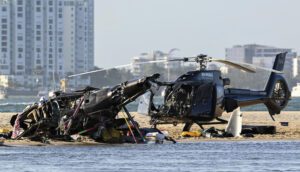Claims for injury compensation arising out of the SeaWorld helicopter tragedy face two major legal hurdles in recovering compensation.
Firstly, there is no requirement for commercial operators to insure against claims for psychological injury by non-passengers. That means that any good Samaritan or first responder who helped retrieve bodies at the wreckage site cannot claim under the operator’s mandatory insurance policy for any mental health deficit they may have suffered from the carnage they witnessed. They will be required to take the risk of suing the operator itself – which may prove futile if it is insolvent – or some other responsible party.
 This situation requires immediate amendment to federal legislation[1] by specifying that the insurance policy provided to operators not only insures passengers, but also extends to injuries to the mental health of good Samaritans and first responders on the ground.
This situation requires immediate amendment to federal legislation[1] by specifying that the insurance policy provided to operators not only insures passengers, but also extends to injuries to the mental health of good Samaritans and first responders on the ground.
Secondly, the operator and its insurer can escape all liability even to mutilated passengers for their injuries under Queensland’s Civil Liability Act that came into force in 2002 by arguing that helicopter joy flights are a dangerous recreational activity.
If insurance companies successfully argue that light aircraft travel is inherently dangerous and that they are entitled to liability immunity – like they have already done in NSW – all injured SeaWorld passengers lose their right to recover injury compensation.
A recent NSW case involved a light aircraft pilot crashing into a Ferris wheel that had been negligently erected at the end of an airstrip in a dangerous position by the local council for a beach festival on the NSW mid-north coast in October 2011.
Despite the court ruling that the council was by far the most at fault for the accident, the aircraft occupants were denied all compensation because of the insurer’s successful argument that it had immunity because it was dangerous to travel by light aircraft. [2]
The Civil Liability Act came into force in Queensland in 2002, but there has been no ruling here as yet as to whether such travel is considered a dangerous activity.
Aviation insurers always claim liability immunity for claims arising out of private flights and commercial training. The situation in other commercial operations – like Seaworld and charter flights (and airline travel as well) – is a little different.
Ordinarily for those flights, an injured passenger can claim up to $925,000 for their proven and medically verified losses if they are injured as a result of an accident without having to prove precisely how it occurred and who exactly was at fault. This is derived from federal legislation which also carries the requirement for such operators to effect mandatory passenger insurance.
In the last couple of years there has however been some controversy over the extent to which the federal law “picks up” provisions of a state’s Civil Liability Act. This too has not yet been addressed by any Queensland court but insurers have argued in favour of such interpretation on at least three occasions.
All three cases related to international airline travel. One federal court judge decided in favour of the insurer’s argument [3], while another federal court judge [4] and a Victorian judge [5] have ruled against it.
The SeaWorld circumstances carry a further complication. While carriage-for-reward passengers’ compensation rights are derived from a federal law, they are implemented – in the case of all intra-state travel including for joy flights at SeaWorld – by a State act [6].
Does this boost an insurer’s opportunity to convince a court that the state’s own Civil Liability Act should limit their liability? Can the insurer claim immunity in the case of non-airline operations on “dangerous recreational activity” grounds?
Queensland is a decentralised state with general aviation light aircraft operations being a mainstay for communication and transport in rural and remote areas.
Most Queenslanders who travel in light aircraft around our magnificent state would be surprised to hear that they are disqualified from compensation for any injuries they might unfortunately sustain as a result of the negligence an airport operator, a fuel supplier, an aircraft maintenance organisation, another aircraft, an air traffic controller or a pilot.
The Queensland government should immediately amend s 18 of the Civil Liability Act to clarify that light aircraft travel does not come within the definition of “dangerous recreational activity”. Injured passengers must be spared from the legal jeopardy of having to navigate a dangerous path in order to recovery from their injuries.
Footnotes
[1] Civil Aviation (Carriers’ Liability) Act 1959 Part IVA.
[2] Arndell BHT Arndell v Old Bar Beach Festival Incorporated; Cox v Mid-Coast Council – [2020] NSWSC 1710 Rothman J, 1 December 2020
[3] Grueff v Virgin Australia Airlines Pty Ltd [2021] FCA 501 Griffiths J, 12 May 2021
[4] Bradshaw v Emirates [2021] FCA 1407 Stewart J, 12 November 2021
[5] Di Falco v Emirates Keogh J, [2018] VSC 472, 24 August 2018
Categories: aircraft accident , Aviation Law


